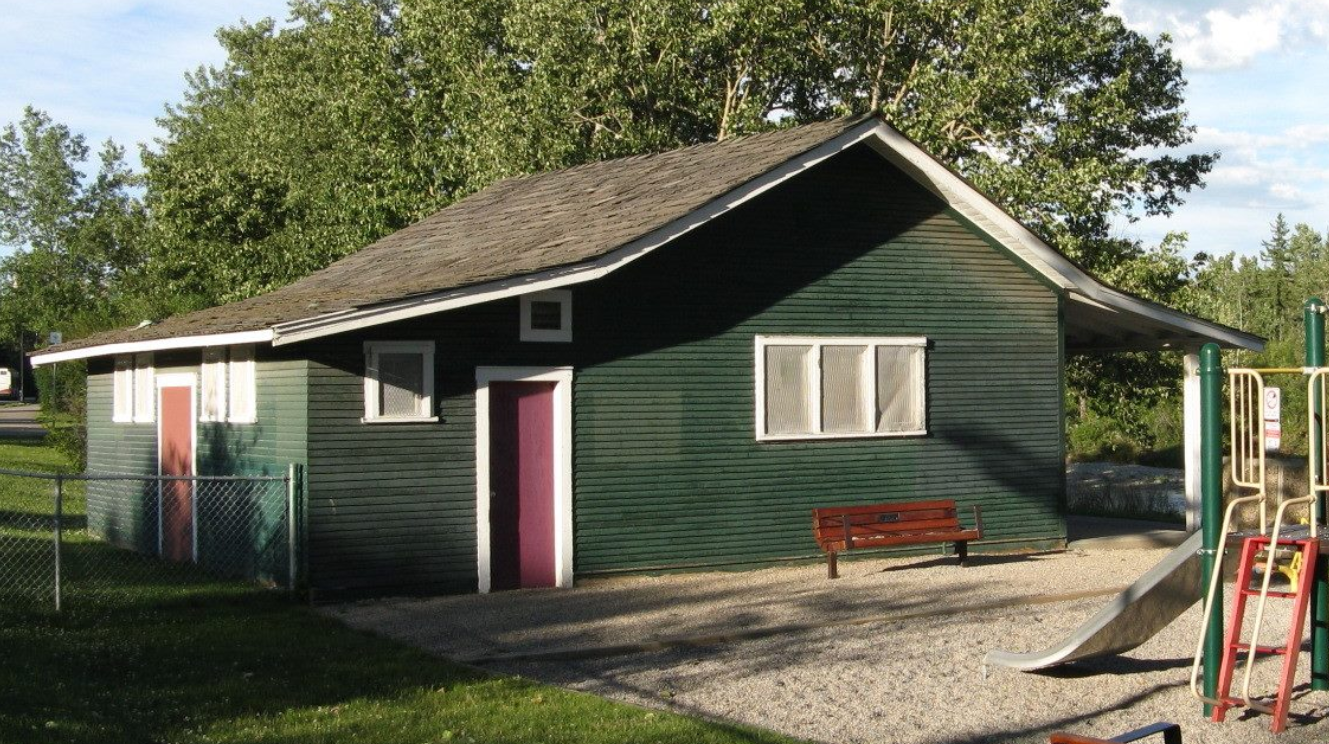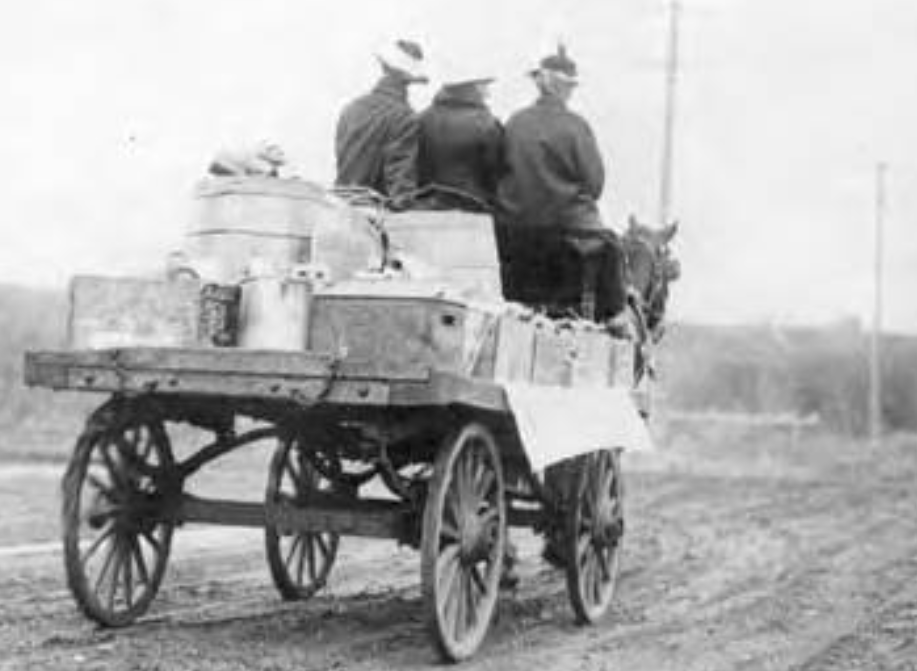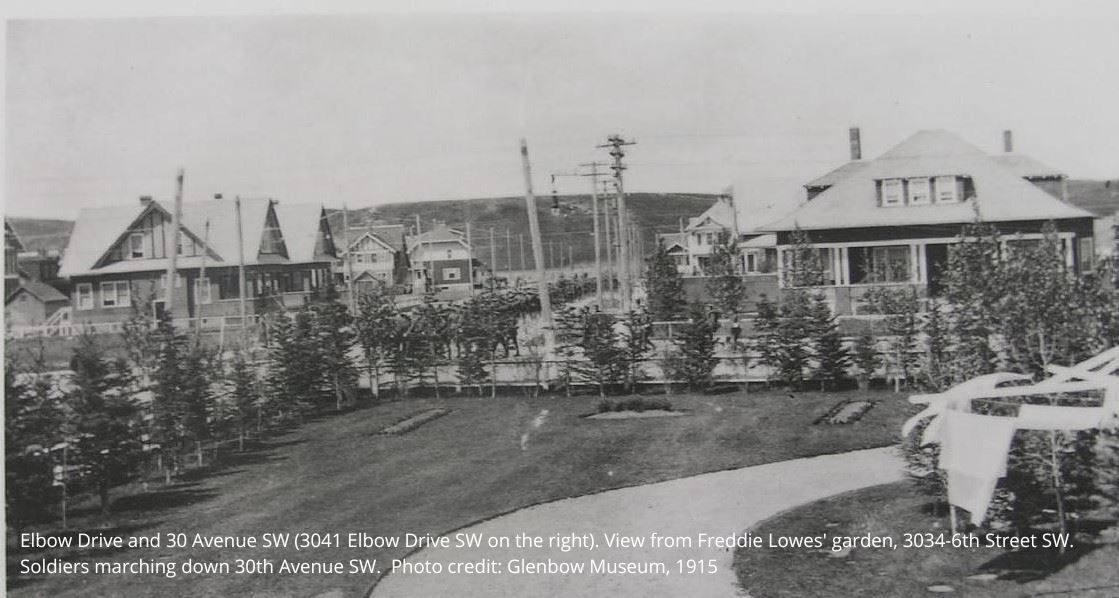Early HistoryMost of the area comprising modern Elbow Park was homesteaded in the late 19th century by William Scollen as early as 1875, and James Owens and James Morris in 1882-83. The City of Calgary annexed the area in 1907 and real estate developer Freddy Lowes and his associates bought and surveyed it. Lowes intended to create an exclusive residential suburb with spacious lots and lovely homes, situated on the pleasant banks of the Elbow River. The first few houses were built in 1909, including Lowes’ own residence. Construction began in earnest the following year. The boom in Calgary was short lived and ended with World War One. By then the neighbourhood of Elbow Park was firmly established as one of the city’s first purpose designed residential suburbs and one of the last to be built before the war. |
Elbow Park Swim Shack
|
Double Murder on Elbow Drive
By Tracey J. Johnson
November 30, 2020
Tucked away on the northwest corner of Elbow Drive and the Elbow River sits an unassuming two story home that belies it's sad history.
Their two other children, Ann, age 12, and John, age 8, were sleeping outside in a summerhouse and were left unharmed. The Byrnes had lived in that home since 1940.
Francis Philip Byrne (born January 24, 1900), originally from Montreal, came to Alberta in 1919 to join the Alberta Provincial Police Force, serving with them until 1922. Byrne went back to Montreal, returning to Alberta again in 1925, working in a brokerage firm, and then at his own investment banking business, Gray, Byrne and Company, in 1931.
Prior to the tragedy, Byrne had suffered a nervous breakdown and had been under professional medical care.Reference:
https://www.glencoegolf.org/documents/10184/41706574/The-History-of-Elbow-Park.pdf
http://www.rcmpgraves.com/buffalo/mountiemarredmurder.html
Sifton Boulevard and Riverdale Avenue have been listed as an historic resource as part of the city’s Conserving Calgary’s Historic Streets Plan.
Click here to read more...
Elbow Park’s Historic Boulevards
By Tracey J. Johnson
December 14, 2020
The Calgary Heritage Authority evaluated streetscapes in 2011 to determine if they had historic significance, to add to Calgary’s Inventory of Historic Resources. 27 historic streetscapes located in 10 Calgary communities were chosen as meeting the criteria to be a Calgary historic streetscape by meeting the following conditions prior the evaluations:
- Association with William Reader - all streetscapes were planted under the direction of William Reader, Parks Superintendent.
- Documented planting date.
- Demonstrated integrity - enough plant material is remaining to effectively illustrate the intent of the streetscape development - continued use of the original plant material along with regularly spacing between plant materials.
Two Streetscapes from Elbow Park were included - Sifton Boulevard SW (from Elbow Drive to 7 Street SW) and Riverdale Avenue SW (from 9 Street to 10 Street SW); both were originally planted in 1929.
The Sifton stretch consists of two landscaped boulevards and includes the regularly spaced pattern of green ash trees (Fraxinum mandshruica) with a “manicured turf understory that separates the sidewalk from the south side of the carriage way with a manicured turf understory that is adjacent to the carriage way on the north side”.
The Riverdale stretch consists of two landscaped boulevards and includes the regularly spaced pattern of elm trees (Ulmus Americana) with remnants of honeysuckle shrubs (Lonicera tatarica) on the south side with a “manicured turf understory that separates the sidewalk from the carriage way on both sides of the street”. There is a historic sidewalk stamp at 10 Street.

 Heroism in Elbow Park
Heroism in Elbow Park
In the mid 1950’s, long time Elbow Park resident John Heffer was witness to two separate acts of life-saving heroism in Elbow Park: In December 1954 I remember walking home from school along Wood's Park with my buddies, when we saw smoke pouring out of a house across Elbow Drive. We wondered how to get help, because nobody had a cell phone! (Was there even 911?). Then the face of an elderly woman appeared in the upstairs window, and the bravest of us, quick-thinking David Johnson, ran across the street and entered the house, where he managed to save one little boy and help with the evacuation of the other residents.
Then again, as a boy of 13 in August 1955, I remember walking along the Elbow River pathway right by the historic home of Freddie Lowes, and arriving at a scene of great drama and possible tragedy. Jim Rogan was resuscitating a boy, Dale Scully, who was close to death from drowning in the river. I remember Jim's name because he worked with my father, Arthur Heffer, at the Bank of Commerce in Calgary. Back in June 2018 I wondered if the story was in the Calgary Herald archives, so I looked Jim up on the internet and found out that he had passed away just two months before, in Winnipeg. His obituary made no mention of his heroism so I searched for, and then attached the Herald article about the event to his obituary for the benefit of his family, who were thrilled to know the story.
In December 1954, 13-year-old David Johnson (944 38 Ave SW) carried a 3-year-old out of a burning house on 3213 Elbow Drive. Click here for full story…
In August 1955, Alfred Petzold* (4010 Elbow Dr). Jim P. Rogan (1415 2 St SW) and James Little (226 25 Ave SW), pulled a drowning 12-year-old out of the water at the Elbow Park swimming hole and resuscitated the blue, unconscious boy until the fire department arrived to finish the job. Click here for full story…
*“Fun” Fact – Alfred Petzold may have committed murder 18 years later in Hamilton.




.png)
.png)




